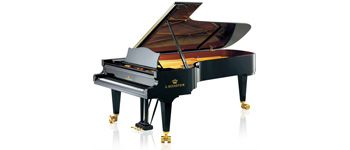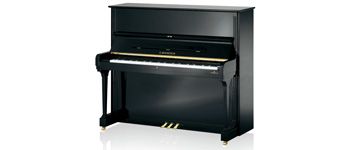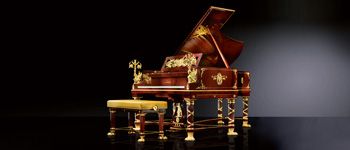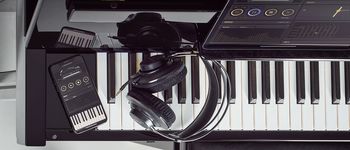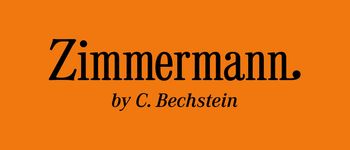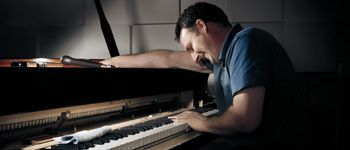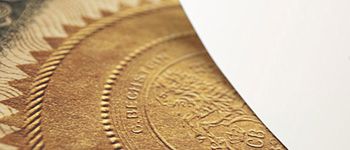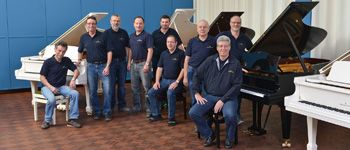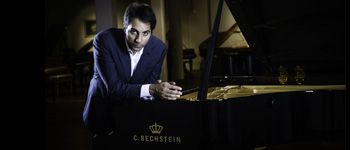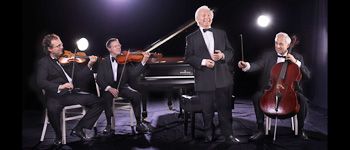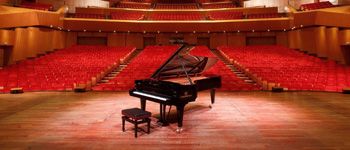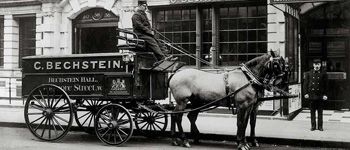Bechstein-Tradition
Highest quality since 1853. Browse through the history of our company.
A proud pioneer: Carl Bechstein leaning on one of his uprights
Although it is purely coincidental that his relative Ludwig Bechstein publishes his masterpiece, Deutsches Sagenbuch, in the same year, the fame of the writer is to have positive effects on that of the piano-maker in Berlin’s cultivated circles.
As soon as he is running his own business, Bechstein uses the contacts he made with noted artists when he was working with Perau. These include Theodor Kullak, piano teacher of the royal family, who praises Bechstein’s first pianos, which boosts their fame. A former pupil of Carl Czerny and a “classical virtuoso”, Kullak founded the “Music School for Singing, Piano and Composition” together with violinist Julius Stern and composer Adolf Bernhard Marx in 1850. (The school is to become the famous Stern Conservatory later on.)
From an economical point of view, founding a company in Berlin is also the right decision as Prussia is Germany’s largest and most powerful German State in the mid-19th century. This is of crucial importance in a time when every sovereign arbitrarily levies customs duties on goods to be sold on his territory, which severely impairs the exchange of commodities within Germany. Moreover, as Prussia dominates the above-mentioned Customs Union, Berlin-based companies enjoy considerable commercial advantages.
Another favourable factor for founding a new piano business is that division of labour appears in the piano-making industry as early as the mid-19th century: J.C.L. Isermann opened Germany’s first action manufacturing plant in Hamburg in 1842; Charles Gehrling and Henry Schwander did the same in Paris nearly at the same time; Morgenstern & Kontrade founded a similar business in Leipzig in 1846; and Lexow is to produce piano actions in Berlin from 1854 onwards, just one year after Bechstein made his first instruments. All these companies have standardised their production and can therefore deliver piano actions at more affordable prices.
Carl Bechstein, who planned his move carefully, now further develops his contacts with artists. After Theodor Kullak, another pianist is to play an even more important role in the piano-maker’s success: Hans von Bülow, a young artist from Dresden who studied with Franz Liszt and is just starting his performer career.
While Bechstein is gluing, planing down and varnishing his two first pianos, Bülow is performing in remote provincial manors and, in his best engagement, in the residence of one of the numerous German princes. Although he enjoys a relative local fame, Bülow remains dependent on his mother’s financial support. He is a brilliant performer who pays more attention to perfect execution than to sound quality. In order to boost his career, he moves to Berlin in 1855 and succeeds Kullak as piano teacher at the Music School for Singing, Piano and Composition. As he arrives in the Prussian capital, he lives “at Adolf Bernhard Marx’s, Behrenstrasse 4, second floor,” which is in the direct vicinity of Perau’s warehouse and Bechstein’s workshop.
One of the magnificent C. Bechstein pianos made for the high society
Inspired by the great pianists of his time
In April 1855, Bülow writes in a letter to Liszt, his venerated teacher, that Berlin has “an absolute dearth of passable pianos.” Talking about the instruments made by Stöcker, which are highly en vogue and marketed exclusively by Kullak in Berlin, Bülow states that they are “the most detestable in the world” and of very poor quality compared with those made by Perau. Bülow also mentions that as he was hired for a concert by the Gustav Adolph Association, a Protestant charity organisation, he could chose between a Perau and an excellent piano made by Klemm, a Dusseldorf-based piano-maker that Clara Schumann highly praises. This letter does not mention Bechstein for the simple reason that Carl was not yet making concert grand pianos in 1855.
Just like Bechstein, Bülow is on the threshold of his career in 1855. The latter is only twenty-five, the other four years older. The year 1856 is particularly eventful for Bechstein: he marries, considerably enlarges his workshop in Behrenstrasse and hires more personnel as his business henceforth has a legal form. But the year’s major event is a concert given by Liszt in Berlin, during which the strings of the Érard piano break one after the other under the maestro’s particularly powerful play — which prompts Bechstein to make a really modern concert grand that can withstand as ardent a pianist as Liszt.
So Bechstein builds his first concert grand piano in 1856. Unverified sources pretend that this piano was the hundredth, which is very improbable since we know that Bechstein is to build only 176 instruments until 1859. Bechstein is likely to choose a round number for his first concert grand and to fill the gap of the serial numbers in the following months.
He entrusts this first concert grand to Bülow and the musician discovers state-of-the-art piano technology, with iron reinforcements that make the instrument extremely sturdy. Performing on Bechstein’s piano from early 1857 onwards, Bülow flies from one success to the other. The year before, he had already performed on a Bechstein (probably Carl’s second grand, built in 1854, which was not a concert instrument and had nothing revolutionary) and played in private circles on uprights made by his mentor, as such instruments were acceptable in polite society.
Bülow gives a decisive concert on 22 January 1857. On this occasion, he premieres Liszt’s Sonata in B Minor although Breitkopf & Härtel already published the partition three years before. Because the concert reviews published in the local press are very controversial, Bülow publicly takes a position for Liszt. This attitude is in part the result of his engagement to the composer’s daughter, Cosima Liszt, who is to become his wife in the autumn of 1857 — and to marry Richard Wagner later on. Aside from this family link, however, Bülow enthusiastically loves the work by his former teacher, and states that he could only render it integrally thanks to Bechstein’s exceptional instrument.
This memorable concert introduces Bechstein to the world of Liszt and Wagner. This is not only to boost sales, but also to play a key role in the development of the company philosophy. Indeed, the Sonata in B Minor places very high demands on the pianist… and the piano, especially in the final octaves. An authentic member of the Liszt school, Bülow implements the direct power of his arms and hands, which sets him clearly apart from the great pianists of the early Romantic era, most of whom were famous for their gentle play and the agility of their fingers.
Innovative spirit
Although Carl Bechstein has caught the spirit of the time and built uprights from the very beginning, he henceforth endeavours to make concert grand pianos that meet the requirements of this new, very emotional approach to music. Anyway, making uprights is radically modern in a time when the public — in particular in a conservative city like Berlin — still favours virginals, as such instruments are more elegant in living rooms and deliver a very harmonious sound. In “Athens on the Spree,” another type of preferred instrument is the stately lyraflügel, which, due to its considerable height, fits only in the homes of the well-to-do. On the contrary, uprights are still considered somewhat “proletarian.” But Carl Bechstein, who has understood that the future belongs to such instruments, asserts his avant-garde approach to piano-making as early as 1853, as seen in the above-mentioned picture that depicts him proudly leaning on his first upright with diagonal strings and a height of only 120 centimetres.
Back to the sensational concert given by Bülow in January 1857 on a Bechstein grand piano. On the next day, the pianist writes to Liszt that he played on an instrument made by “a certain Bechstein” that was superior to an Érard piano. Three weeks later, Bülow complains in another letter to the maestro that the Bechstein grand has been sold, so that he must find another one for a concert to be given in Leipzig. This marks the birth of a partnership between Bechstein and Bülow that is to last until their deaths.

A marketing genius
With this partnership, Bechstein implements a marketing strategy that was developed by Érard in Paris and is sensationally new in Berlin: he caters for the needs of various artists, in particular Bülow, of course.
Im bedeutungsvollen Jahr 1856, in dem Bechstein nicht nur heiratete, sondern auch seine Werkstatt in der Behrenstraße wesentlich vergrößerte sowie Mitarbeiter einstellte und möglicherweise sein Gewerbe überhaupt erst offiziell anmeldete, hatte er erlebt, dass Érard Liszt für ein Konzert in Berlin einen Flügel zur Verfügung stellte. Bechstein sah mit an, wie im Verlauf des Abends eine Saite nach der anderen der Belastung nicht mehr standhielt und riss. Er beschloss damals endgültig, den neuen und wirklich modernen Flügel zu bauen, der auch Liszts Spiel gewachsen wäre.
All this occurs while the musical ideal is undergoing radical changes. In 1849, Liszt had begun to compose audacious and sophisticated “symphonic poetries” for the Weimar Orchestra. And in 1841, while Carl Bechstein was working in Paris, Aristide Cavaillé-Coll had built a new organ for the Saint-Denis basilica near Paris, a remarkable instrument that integrated all registers of the French orchestra and thus was the quintessence of Romantic organ. The fact that Emperor Napoleon III commissioned Cavaillé-Coll make similar organs for further Paris’s churches, including La Madeleine, evidences the role of the organ-maker in the advent of the new musical ideal in the 1850s. Incidentally, the organist of La Madeleine as of 1858 was none other than Camille Saint-Saëns, whose spectacular improvisations attracted “tout Paris”… and who was to become a Bechstein aficionado.
Friedrich Ladegast, Germany’s greatest organ-maker of the 19th century, who had been trained by Cavaillé-Coll, refurbished and enlarged the organ of Merseburg’s Cathedral in 1855. This impressive instrument with its eighty-one registers prompted Franz Liszt to revisit his fantasy and fugue on the choral Ad nos, ad salutarem undam (played for the organ’s dedication) and to compose the Prelude and fugue on B-A-C-H. Aware of the organ’s importance in the advent of the Romantic sound, Liszt had several occasions to listen to his colleague Saint-Saëns playing in La Madeleine. Moreover, he possessed a special piano that was famous throughout Europe for its three manuals and “foot keyboard,” an instrument made in Paris by Alexandre Père et Fils using an harmonium and an Érard grand piano. In a letter sent to the Vienna violinist Joseph Hellmesberger in July 1855, Liszt states that this instrument, “made to his instructions”, delivers “effects, nuances and power of remarkable quality and diversity” and achieves an “harmonious synthesis of organ and piano.”
Thus, a new musical ideal arises within just a few years and future-oriented instrument makers endeavour to cope with the new taste. Carl Bechstein is not the only one who feels the changes in his bones, of course, but he will be able to implement them and make exactly the instruments that the pianists of his time are longing for — which is to be his key to success. Thanks to his very sensitive ear, he will deliver what his friend Bülow is to call “Bechstein’s colourful piano.”
Building a great reputation
Now, Carl Bechstein has to face a logistics problem: how to transport the concert grand pianos to the venues where Hans von Bülow is performing? Once again, the young entrepreneur benefits from the technological progress of his time, as the German railroad network is being constantly expanded. In late November 1857, Bülow writes to his friend Alexander Ritter in Stettin where a concert is planed for 1 December with Liszt’s First Piano Concerto in the programme: “In my mind, Bechstein is Germany’s best piano-maker, even though he has only built three grands to date. As I hurried to him, he had already sent the instrument via the railway, so that it is likely to be already waiting for pick-up at Stettin’s station.” Compared with Érard, Bechstein is still a nobody in terms of his insignificant production, but he straightaway positions himself as an entrepreneur who is particularly committed to customers’ satisfaction and thus implements novel marketing and after-sales strategies.
As Bülow sojourns in Paris in 1860, he sends a letter to his friend on 6 March that underscores how tariff barriers impair business between Berlin and Vienna:
“Dear Mr Bechstein, my dear friend, My wife asked you to be so kind and deliver a concert grand to Vienna where I am to perform on 25 March with the Philharmonic Orchestra. My intention was not so much the selfish desire to perform more brilliantly than with a Bösendorfer or a Streicher, as the ambition — which you have not yet approved — to increased your fame abroad thanks to the remarkable pianos that bear your name. I would never in the world deny that a piano from your workshop is best suitable to express my humble talent, more so than any other make. But to be honest with you, you can easily imagine that playing in Vienna with a German piano would increase the number of my enemies, which are already not few down there. In particular, I would have to face the crowd of all piano-makers of the Austrian empire. Anyway, such considerations will not prevent me from implementing an idea that is very pleasant to me: I mean contributing to increase your fame, so that your name becomes as famous throughout Germany as that of Streicher decades ago or that of Érard still today. [...] In your letter, you list the pecuniary drawbacks of my plan and consider that they outweigh the advantages that could result for your company’s fame. As I am not an expert in financial matters, I will give no statement in this respect, even though I would be happy to assume the transport and customs duties as far as I can. […] I am very upset at all that obstructs my project. Nonetheless, this will by no means prevent me from profoundly admiring your achievements as I always have, with true devotion to this day.”
This letter shows that Bülow is as committed to Bechstein’s pianos as he is to Liszt’s or Wagner’s compositions — Just because the Bechstein sound and the new musical ideal developed by the two composers are one and the same thing to him.
